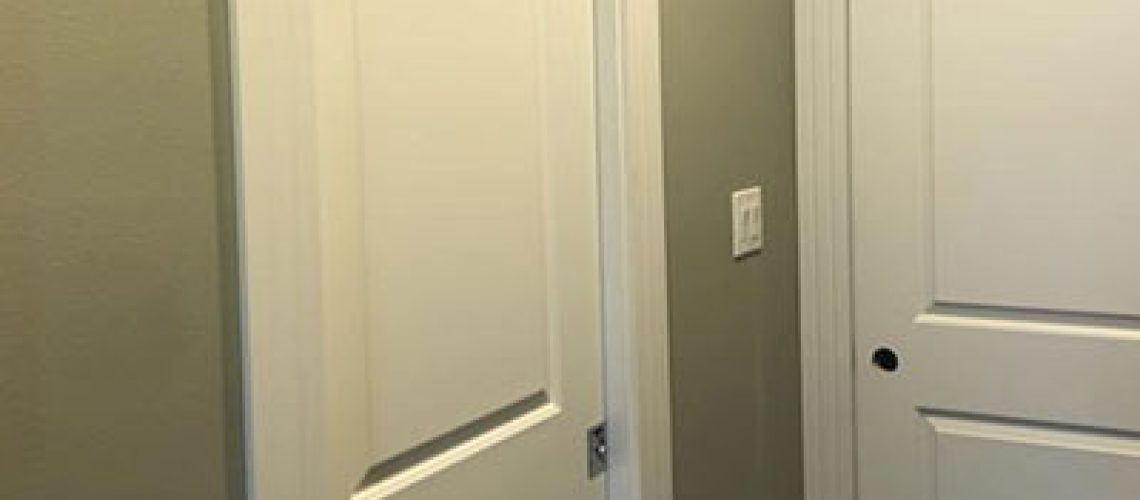Q: How much does it cost to install an interior door?
A: The cost to install an interior door can vary depending on several factors such as the type of door, the size of the door, the type of hardware and the complexity of the installation.
On average, the cost to install an interior door ranges from $250 to $800. If you only need one or two doors installed, expect the price to be on the higher end per door, as there are minimums associated with mobilization and demobilization. Also, if you are looking for a high-end door or if the installation requires extensive customization or modification to the existing frame, the cost can be significantly higher.
It’s recommended to get a few quotes from professional contractors in your area to get a more accurate estimate based on your specific needs and circumstances.
Q: What is the difference between hollow and solid core doors?
A: Hollow core doors and solid core doors are two common types of interior doors that differ in construction and properties.
Hollow core doors are made from a thin exterior skin of plywood or MDF (medium-density fiberboard) with a cardboard honeycomb or wooden frame inside. These doors are lightweight and less expensive than solid core doors. However, they are also less durable and have poor sound insulation properties. They may also be more prone to damage and dents.
Solid core doors, on the other hand, are made from a solid block of wood or composite material like particleboard or MDF. These doors are heavier and more expensive than hollow core doors, but they offer better insulation, durability, and noise reduction properties. They also provide a more substantial feel when opening and closing.
When choosing between hollow core and solid core doors, it’s important to consider your specific needs and budget. Hollow core doors may be more suitable for low-traffic areas or for those who want a more budget-friendly option. Solid core doors may be a better choice for areas that require more privacy or where noise reduction is important, such as bedrooms or home offices.
Q: What is the difference between a stain grade or paint grade door?
A: Paint grade doors and stain grade doors are two different types of doors with different characteristics.
Paint grade doors are typically made from cheaper, more economical materials such as MDF (medium-density fiberboard) or softwoods like pine. They are designed to be painted, and their construction and surface finish are optimized for that purpose. Paint grade doors are often used in areas where appearance is less important and where cost savings are important.
Stain grade doors, on the other hand, are made from higher quality materials such as hardwoods like oak, maple, or cherry. These doors are designed to be stained or clear-coated to highlight the natural beauty of the wood grain. Stain grade doors are often used in areas where appearance is important and where the door is a focal point, such as in entryways or on interior doors.
Overall, the main difference between paint grade and stain grade doors is the quality of the materials used and the intended use. If you’re looking for a cost-effective option and don’t require a specific appearance, a paint grade door may be the best choice. If you’re looking for a high-quality, visually appealing option, a stain grade door may be more suitable.
Q: What type of door should I use? (or “do I need?”)
A: There are several types of interior doors that you can choose from, depending on your needs and style preferences. Keep in mind that the style of door can be the same no matter the type of door used. Here are some of the most common types of interior doors:
- Swing doors: These doors are the most common type of door that are fitted into a frame. They are versatile and can be used in many different styles of homes.
- French doors: These doors are made up of two hinged slabs that swing inwards or outwards. They are commonly used to separate living rooms and dining rooms, or as a divider between a bedroom and a closet. French doors have glass in them while double swing doors are solid. They are a great option for letting light in or making a room feel bigger while still being able to section off a space and create a larger opening for larger furniture to pass through or more people.
- Pocket doors: These doors slide into the wall and are perfect for smaller spaces where a traditional swinging door would take up too much space.
- Barn doors: These doors slide on a track and are a great option for adding a rustic or farmhouse feel to your home. They can be used as room dividers or closet doors. There are many modern looking styles now as well.
- Dutch doors: These doors are divided in half horizontally, allowing the top half to be opened independently from the bottom half. They are often used in kitchens or nurseries to keep children or pets in or out of a space.
- Bi-fold doors: These doors are made up of two panels that are hinged together and fold in half when opened. They are commonly used for closet doors or room dividers. These are used typically when furniture is adjacent to the opening and may be damaged by a swinging door slab or when there isn’t enough clearance to comfortably open a swing door without blocking off another space.
- Bypass doors: These doors are similar to barn doors, however the track is typically concealed with wood trim. There are kits that have mirrored glass doors and are usually installed in bedroom closet openings. Bypass doors are typically used on 4’ to 6’ openings and are used when you don’t want anything projecting into the room space like a bi-fold or swing door would or sliding into furniture along the wall like a barn door would.
Q: How do I fix a door that doesn’t open or close properly?
A: check out our blog post “When you have a swing door that doesn’t seem to operate properly anymore.” For other types of doors, check to make sure the door isn’t damaged, especially around the attached hardware. Check that the opening looks like it is in good condition. If you see cracking or splitting, or if the mounting locations for the hardware look worn, you may need to repair the framing or use larger fasteners to secure everything properly. Installing new plastic anchors may also help with loose fasteners. If you still can’t get it or just don’t want to mess with it and need some professional assistance, go to our CONTACT US page and reach out to us

